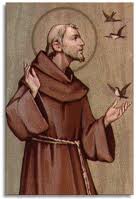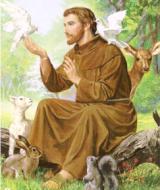


Most Franciscans are members of Roman Catholic religious orders founded by Saint Francis of Assisi. Besides Roman Catholic communities, there are also Old Catholic, Anglican, Lutheran, ecumenical and Non-denominational Franciscan communities.
The most prominent group is the Order of Friars Minor, commonly called simply the "Franciscans." They seek to follow most directly the manner of life that Saint Francis led. This Order is a mendicant religious order of men tracing their origin to Francis of Assisi. It comprises three separate groups, each considered a religious order in its own right. These are the Observants, most commonly simply called "Franciscan friars," the Capuchins, and the Conventual Franciscans. They all live according to a body of regulations known as "The Rule of St. Francis".
The official Latin name of the Orders of Friars Minor is the Ordo Fratrum Minorum. St. Francis thus referred to his followers as "Fraticelli", meaning "Little Brothers". Franciscan brothers are informally called friars or the Minorites. The modern organization of the Friars Minor now comprises three separate branches: the 'Friars Minor' (OFM); the 'Friars Minor Conventual' (OFM Conv), and the 'Friars Minor Capuchin' (OFM Cap)
The women who comprise the "Second" Order of the movement are most commonly called Poor Clares in English-speaking countries. The order is called the "Order of St. Clare" (O.S.C.).
The Third Order, or Third Order of Penance, has tens of thousands of members, as it includes both men and women, both living in religious communities under the traditional religious vows, as well as those who live regular lives in society, while trying to live the ideals of the movement in their daily lives.
sermon which Francis heard in 1209 on Mt 10:9 made such an impression on him that he decided to devote himself wholly to a life of apostolic poverty. Clad in a rough garment, barefoot, and, after the Evangelical precept, without staff or scrip, he began to preach repentance.
He was soon joined by a prominent fellow townsman, Bernardo di Quintavalle, who contributed all that he had to the work, and by other companions, who are said to have reached the number of eleven within a year. The brothers lived in the deserted lazar-house of Rivo Torto near Assisi; but they spent much of their time traveling through the mountainous districts of Umbria, always cheerful and full of songs, yet making a deep impression on their hearers by their earnest exhortations. Their life was extremely ascetic, though such practices were apparently not prescribed by the first rule which Francis gave them (probably as early as 1209), which seems to have been nothing more than a collection of Scriptural passages emphasizing the duty of poverty.
In spite of some similarities between this principle and some of the fundamental ideas of the followers of Peter Waldo, the brotherhood of Assisi succeeded in gaining the approval of Pope Innocent III.What seems to have impressed first the Bishop of Assisi, Guido, then Cardinal Giovanni di San Paolo and finally Innocent himself, was their utter loyalty to the Church and the clergy. Innocent III was not only the Pope reigning during the life of St. Francis of Assisi, but he was also responsible for helping to construct the Church Francis was being called to rebuild. Innocent III and the Fourth Lateran Council helped maintain the church in Europe. Innocent probably saw in them a possible answer to his desire for an orthodox preaching force to counter heresy. Many legends have clustered around the decisive audience of Francis with the Pope. The realistic account in Matthew Paris, according to which the Pope originally sent the shabby saint off to keep swine, and only recognized his real worth by his ready obedience, has, in spite of its improbability, a certain historical interest, since it shows the natural antipathy of the older Benedictine monasticism to the plebeian mendicant orders. The group was tonsured and Francis was ordained as a deacon, allowing him to read Gospels in the church.
Francis had to suffer from the dissensions just alluded to and the transformation which they operated in the originally simple constitution of the brotherhood, making it a regular order under strict supervision from Rome. Exasperated by the demands of running a growing and fractious Order, Francis asked Pope Honorius III for help in 1219. He was assigned Cardinal Ugolino as protector of the order by the Pope. Francis resigned the day-to-day running of the Order into the hands of others but retained the power to shape the Order's legislation, writing a Rule in 1221 which he revised and had approved in 1223. At least after about 1223, the day-to-day running of the Order was in the hands of Brother Elias of Cortona, an able friar who would be elected as leader of the friars a few years after Francis' death (1226) but who aroused much opposition because of his autocratic style of leadership. He planned and built the Basilica of San Francesco d'Assisi in which Saint Francis is buried, a building including the friary Sacro Convento, which still today is the spiritual centre of the order.


|
Date |
Name of the Friars |
Events |
Year |
|
01 |
Charles Mathew Kolanchery |
Birth |
1947 |
|
02 |
Joseph Raj M. |
Birth |
1975 |
| 03 | Bl. Helene Enselmini, OSC | 1242 |
|
|
04 |
St. Charles Borromeo, OFS Bl. Teresa Manganiello, OFS Charles Bernard |
Birth |
1584 1876 1963 |
|
05 |
Lawrence Simon Bala Marneni + Thomas Thannikary + Bernard D’ Silva |
Birth Birth Home Home |
1949 1962 1996 2010 |
|
06 |
Bl. Marguerite deLorraine, OSC Singarayar A. Salvador D’Souza |
Birth Birth |
1521 1970 1979 |
|
07 |
St. Didacus of Alcala, OFM Bl. Raynier of Arezzo, OFM Hemant Xess |
Birth |
1463 304 1975 |
| 08 | Bl. John Duns Scouts OFM | 1308; |
|
|
09 |
Bl. Gabriel Ferreti, OFM Saji P. Mathew |
Birth |
1456 1975 |
|
10 |
Bl. Louis Guanella, OFS Augustine Pinto + Wilbert Smit |
Birth Home |
1340 1936 2003 |
|
11 |
Bl. Mary Crucifixa, OFS Fulgence Ekka Basil S. Lobo |
Birth Birth |
1826 1964 1971 |
| 12 | Bl. Giovanni della Pace, OFS | 1433 |
|
| 13 | St. Didace d’ Alcala, OFM | 1463 |
|
|
14 |
Franciscan Martyrs of Palestine + Mark O’Rourke Salvador Drego |
Home Birth |
1391 1974 1984 |
|
15 |
Bl. Sebastian de Jesus OFM Bl. Mary of the Passion FMM + Anthony Almeida |
Memoria Home |
1734 1904 1970 |
|
17 |
St. Elizabeth of Hungary Patroness of the OFS Bl. Jeanne de Signa, OFS |
|
1231 1307 |
|
18 |
Bl. Salome of Cracow, OFS |
|
1268 |
|
19 |
St. Agnes of Assisi, OSC Bl. Maria Milagros, OSC Thomas Joseph +Kamal Ekka |
Birth Home |
1253 1936 1962 2008 |
|
20 |
Franciscan Martyrs of Spain Irudayaraj Fernando + Bonaventure Davis + Bishop Ambrose Y +Jesu Irudayam |
Birth Home Home Home |
1936 1966 1971 1997 2009 |
|
22 |
Franciscan Martyrs of Armenia +Joachim Tinneny |
|
1895 2009 |
|
23 |
Bl. Marie de Jesus, Third Order Regular + John C. O’Dowda Maria Ratheesh Jenive |
Home Birth |
1902 1982 1999 |
|
24 |
Bl. Timothy Trajonowski, Conv Rajesh Praveen Kumar |
Birth |
1942 1994 |
|
25 |
All Deceased of the Seraphic Order St. Humilis of Bisgnano, OFM Bl. Elizabeth of Reute, Third Order Regular Carlos Dias Tojy M. |
Birth Birth |
1637 1420 1959 1970 |
|
26 |
St. Leonard of Port Maurice, OFM Balthazar Pinto |
Feast Birth |
1751 1960 |
|
27 |
St. Francis Anthony Fasani, Conv Johnson M. V. |
Feast Birth |
1742 1969 |
| 28 | St. Jams of La Marca, OFM | Feast | 1476 |
|
29 |
All Saints of the Seraphic Order Dependent Custody Foundation,North East. Amaladass Manickam |
Feast Erection Ordination |
2008 1985 |
|
30 |
Bl. Antoine Bonfandini, OFM Prasad Papabathuni |
Birth |
1482 1970 |